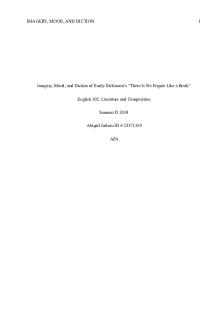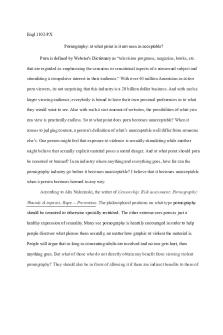Apple - Grade: 80 PDF

| Title | Apple - Grade: 80 |
|---|---|
| Author | Mayar Darbi |
| Course | International financial management |
| Institution | University of Windsor |
| Pages | 8 |
| File Size | 228.7 KB |
| File Type | |
| Total Downloads | 60 |
| Total Views | 198 |
Summary
Apple essay for harvard...
Description
Mayar Darbi 104738980 Corporate Financial Strategy Professor Minjie Zhang Assignment 6: Apple
Introduction
Apple Inc. is a multinational, multi-billion - dollar company that has become a digital electronics brand name. The company was able to segment its position into the mobile, tablet, music streaming, and video services industries. Apple developed exponentially from the beginning of 2000 until 2012, after starting with PCs. Investors are nervous, however, because they suspect that Apple is hoarding cash instead of reinvesting in the business or paying out dividends. Question 1
In the past decade, Apple has been quite successful, largely due to the quality of the management in place (Tim Cook and Steve Jobs). Their ambition and ability to take risks with the company have made it possible for Apple to be a key innovator and pioneer in new markets. The company was primarily responsible for the launch of the iPhone, iPod, and iTunes stores. There was a large consumer base and loyalty present due to the degree of creativity and reputation for making quality products. This is also demonstrated by the fact that 270,000 iPhones were sold within 30 hours of the launch of the device. And the best thing is that, without burdening itself with debt or over-leveraging, Apple was able to make these steps. Apple had begun to face some challenges amid these successes, both from inside the company and outside the company. Externally, with the introduction of Android smartphones into the market, the market for phones has become increasingly competitive. This increased competition was beginning to eat away at the strong market presence and earnings of Apple. Internally, Steve Jobs, one of the main innovators and cofounders, began to get ill, which was a red flag for investors because he was credited to a large majority of the company’s success, and so there was an increasing fear that the company could not succeed without jobs present. In addition, Apple had already accrued approximately $137 billion in cash storage, and
investors were beginning to fear that Apple was not using those funds to their advantage. This has created a split among investors who are upset that the money is not being used as dividends for fresh research & growth, investment in innovation, or being returned to shareholders. Apple had a current ratio of 4.33 and a gross profit ratio of 27 percent in the year 2000. Then, the current ratio was 6.28 in the year 2012, showing a substantial increase in its cash. The gross profit ratio was also 44 percent, showing how Apple kept reducing manufacturing costs when producing a lot of profit. The gross profit ratio was also 44 percent, showing how Apple kept reducing manufacturing costs while making massive amounts of profit. Que s t i o n2
Apple continues to keep significant amounts of cash, according to Steve Jobs' comment, in order to be able to deploy rapidly and take advantage of key strategic possibilities. These opportunities are primarily focused on research & growth, mergers & acquisitions, and new technology investments. Apple would not need to pursue financing with a huge amount of cash and could seek full returns on its investments. The company has taken advantage of tax-saving FY 2012 - $ Billions opportunities worldwide, which is reflected in the company's decision to 121.2 Cash & Marketable Securities retain about 69% of 5 Ireland's cash balances. Apple has around $72 Cash Overseas (69% of Cash) 83.66 billion in 'excess currency' as per the exhibit below: Repatriation tax (35% of Cash Overseas) 29.28
Cash left after repatriation (cash – rep tax)
91.96
SG&A
10.04
Required Cash (SG&A x 2)
20.08
Excess Cash
71.89
Over the next 5 years, Apple will choose to allocate this money. The distribution can be modelled in the following exhibit, provided the two assumptions of an annual revenue growth of 10 percent and an interest rate of 5.6 percent:
Que s t i o n3 Ap p l e ’ sd i vi d e n dp a y me n tc a nb ec a l c u l a t e da spe rt h ee x h i b i tb e l o w:
FY 2011 - $ Millions
Net Income
25,922 .00
Plus: Depreciation & Amortization
1,814. 00
Cash Flow from Operations to Equity Investors
27,736 .00
Minus: Preference dividend
-
Minus: CapEx
4,260. 00
Minus: Working Capital Needs
4,270. 00
Minus: Principal Repayment
-
Plus:Proceed from New Debt Issues -
FCF to Equity
27,746 .00
Dividend Paid Annually (FCFE/5)
5,549. 20
Ap p l ec o u l da l s oc o n t i n u et opa ys h a r e ho l d e r sne a r l y$ 5 . 5b i l l i o npe ry e a ri nd i v i de n d s . Que s t i o n4 Th ee x c e s sc a s ha f t e r2 0 1 2c a nb ec a l c ul a t e da sp e rt h ee x h i b i t :
Q1 2013 - $ Millions
Cash & Marketable Securities
137,112 .00
Cash Overseas
94,607. 28
Repatriation Tax (35% of overseas cash)
33,112. 55
Cash & Marketable Securities Repatriation Tax
103,999 .45
Required Cash
20,550. 00
Excess Cash
83,449. 45
Wi t ha ne x c e s so f$ 8 3. 5b i l l i o ni nc a s h , t h i sme a n st h a t8 3 , 44 9 . 45 / 4 5 0 . 5o r1 8 5, 2 3 7mi l l i o n s h a r e sc o u l db er e p u r c h a s e da t as ha r ep r i c eo f$ 4 50 . 5 .
Th ed i v i d e n d sp a i da r ep r o p o r t i o n a lt ot hea mo u n tofs u r p l usc a s hd i vi d e db yt h en u mbe ro f o u t s t a nd i n gs h a r e s , wh i c hi se q u a lt o9 3 9. 1mi l l i o n. Th i si mpl i e st h a t8 3 , 4 4 9 . 4 5 / 9 3 9. 1 , or$ 8 8 . 8 6 p e rs h a r e ,wo u l db ep a i do u t . Gi v e naf a c ev a l u eof$ 5 0a n da na n n u a ld i v i de n do f$ 2 , t h i sme a n st h a tt h ea mo u nts p e n to n i Pr e fs t oc ki se q u a lt ot hen u mbe ro fou t s t a n d i n gs h a r e sd i v i d e db y10 , o r$ 9, 9 9 1mi l l i o n ,a st heP /Er a t i oi ss e ta t 1 0 . Asi tb ui l d sv a l u ef o rt h eb us i n e s sa n dh o l dsi n v e s t o rs e n t i me n tu p , Co o ka n d Op p e n h e i me rc a np r o c e e dwi t ht h es t o c kr e p u r c h a s ea n dd i v i d e n dpa y me n t s ....
Similar Free PDFs

Apple - Grade: 80
- 8 Pages

A1 - Grade: 80
- 5 Pages

Gout(notes) - Grade: 80
- 3 Pages

HD sample - Grade: 80%
- 16 Pages

Poetry Essay - Grade: 80%
- 6 Pages

Business summative - Grade: 80
- 17 Pages

Essay 3 - Grade: 80
- 4 Pages

FADO Music - Grade: 80%
- 7 Pages

Apple - Grade: B
- 2 Pages

The lindy hops - Grade: 80
- 2 Pages

Final lab report - Grade: 80
- 15 Pages

Peter the great - Grade: 80
- 1 Pages

Apple Pt I - Grade: A
- 5 Pages

Apple case study - Grade: B+
- 21 Pages

ABC group assignment - Grade: 80~90
- 23 Pages
Popular Institutions
- Tinajero National High School - Annex
- Politeknik Caltex Riau
- Yokohama City University
- SGT University
- University of Al-Qadisiyah
- Divine Word College of Vigan
- Techniek College Rotterdam
- Universidade de Santiago
- Universiti Teknologi MARA Cawangan Johor Kampus Pasir Gudang
- Poltekkes Kemenkes Yogyakarta
- Baguio City National High School
- Colegio san marcos
- preparatoria uno
- Centro de Bachillerato Tecnológico Industrial y de Servicios No. 107
- Dalian Maritime University
- Quang Trung Secondary School
- Colegio Tecnológico en Informática
- Corporación Regional de Educación Superior
- Grupo CEDVA
- Dar Al Uloom University
- Centro de Estudios Preuniversitarios de la Universidad Nacional de Ingeniería
- 上智大学
- Aakash International School, Nuna Majara
- San Felipe Neri Catholic School
- Kang Chiao International School - New Taipei City
- Misamis Occidental National High School
- Institución Educativa Escuela Normal Juan Ladrilleros
- Kolehiyo ng Pantukan
- Batanes State College
- Instituto Continental
- Sekolah Menengah Kejuruan Kesehatan Kaltara (Tarakan)
- Colegio de La Inmaculada Concepcion - Cebu
